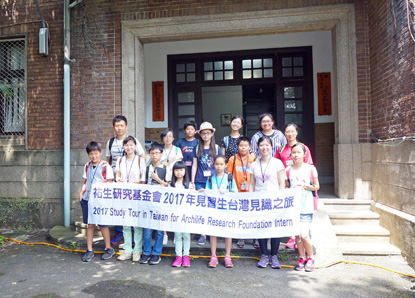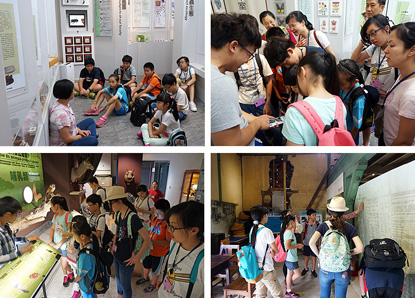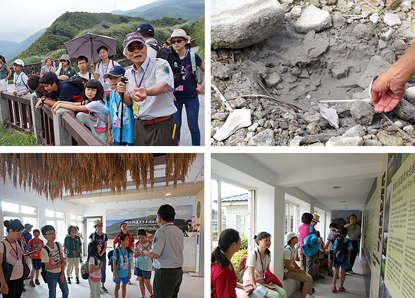Sketch of Archilife Study Tour, June 2017Date: 2017-07-10
Section: Activity |  6月份見識之旅活動,於2017年6月10日由呂明澐小姐帶領13位祐生見習生及家長們,進行台大博物館暨蓬萊米原鄉探索之旅。出發當日台北天氣晴朗,見習生們及其家長準時集合並出發。活動開始之初,領隊呂明澐小姐提醒本次活動注意事項及觀察重點,先行建立見習生的背景知識。 6月份見識之旅活動,於2017年6月10日由呂明澐小姐帶領13位祐生見習生及家長們,進行台大博物館暨蓬萊米原鄉探索之旅。出發當日台北天氣晴朗,見習生們及其家長準時集合並出發。活動開始之初,領隊呂明澐小姐提醒本次活動注意事項及觀察重點,先行建立見習生的背景知識。
For the study tour of June 10, 2017, Ms. Lu Ming-yun led 13 ARF interns and their parents on a discovery tour to NTU Museums and home of the Japonica rice. It was clear and sunny in Taipei on the day of the tour, and the interns and their parents were on time for the departure. At the start of the day's activities, team leader Ms. Lu Ming-yun reminded everyone about things to note and what to observe, and provided the interns some general background knowledge.
 本次上午行程以台大博物館群為主軸,成員館共有十處,係台灣大學將其豐富的館藏,做妥善保存、推廣利用及教學研究而設。此次分別參訪昆蟲標本館、動物博物館及磯永吉小屋。首先至昆蟲標本館參觀,透過主題式的標本陳列,讓眾人了解何謂民俗昆蟲、食用昆蟲等,更進一步認識昆蟲的特徵、習性及牠們與人類日常生活的文化相關性。接著至動物博物館,起初播放以動物「聲音」為題的影片,來顯現多樣性的生態及動物本能,再由導覽人員詳細講述影片中出現之動物,以問答方式與見習生互動,過程精彩有趣。 本次上午行程以台大博物館群為主軸,成員館共有十處,係台灣大學將其豐富的館藏,做妥善保存、推廣利用及教學研究而設。此次分別參訪昆蟲標本館、動物博物館及磯永吉小屋。首先至昆蟲標本館參觀,透過主題式的標本陳列,讓眾人了解何謂民俗昆蟲、食用昆蟲等,更進一步認識昆蟲的特徵、習性及牠們與人類日常生活的文化相關性。接著至動物博物館,起初播放以動物「聲音」為題的影片,來顯現多樣性的生態及動物本能,再由導覽人員詳細講述影片中出現之動物,以問答方式與見習生互動,過程精彩有趣。
The morning's itinerary revolved around NTU Museums. The NTU Museums, which consists of 10 museums, have been established to preserve, promote and utilize NTU's extensive collections, and use them for educational and research purposes. The museums visited included the Insect Museum, Museum of Zoology and Workshop of Advanced Academy of Agronomy and Forestry(Iso House). The first museum visited was the Insect Museum. Everyone learned about insects in culture and edible insects, and had better understanding of insect characteristics and habits, and the cultural connection between insects and human beings' everyday living. The next museum visited was the Museum of Zoology. A film based on the theme "animal sounds" was screened to demonstrate diversity and animal instinct, and then the tour guide explained about the animals in the film, and interacted with the interns through Q&A.
離開動物博物館後,來到磯永吉小屋,屋內保存早年磯永吉先生於台北高等農林學校做稻米研究時,留下的器具如:種子篩、Ernst Leitz Wetzlar顯微鏡與書籍文件,為在來稻改良育種成蓬萊米做了歷史見證。
The next museum visited was Iso House. The house preserved equipment used by Iso Eikichi when he was researching rice at the Workshop of Advanced Academy of Agronomy and Forestry, including seed sieve, Ernst Leitz Wetzlar microscope and books/documents. It bears witness to the historical improvements and modifications made to create the Japonica rice.
 午餐後,乘車前往陽明山小油坑,導覽人員帶領眾人沿著步道走至觀景台,沿途講解小油坑周圍的生態環境、地理位置與終年冒煙的景象,接著移至崩塌地形觀賞步道進行解說,以溫度計實際測量冒煙處的溫度,並將冷水倒入其中,親眼見證剛倒入的水馬上沸騰翻滾,溫度之高由此可見。 午餐後,乘車前往陽明山小油坑,導覽人員帶領眾人沿著步道走至觀景台,沿途講解小油坑周圍的生態環境、地理位置與終年冒煙的景象,接著移至崩塌地形觀賞步道進行解說,以溫度計實際測量冒煙處的溫度,並將冷水倒入其中,親眼見證剛倒入的水馬上沸騰翻滾,溫度之高由此可見。
After lunch, everyone took the bus to Siaoyoukeng Recreation Area at Yangmingshan National Park. The tour guide led everyone along the trail to the viewing deck. On the way the tour guide explained the ecological environment around Siaoyoukeng, its geographical location and why there is steam rising from it all year round. When everyone got to the viewing deck at the landslide terrain, the tour guide used a thermometer to measure the temperature of rising steam. Everyone witnessed how hot the steam was when the tour guide poured cold water in and the water immediately started boiling.
行程最後,來到竹子湖蓬萊米原種田故事館,館內依主題陳列不同的內容,介紹竹子湖做為蓬萊米原種田的因由,並以故事敘述的方式,說明磯永吉先生及末永仁先生的生平事蹟,亦以等比例的人像展示稻米撥穗等作業情形,讓見習生更容易了解稻米收割後的流程。至此,本日活動已近尾聲,大家一起合照留念後各自返家,並期待於下次見識之旅再相見。
The last leg of the day's tour was the Zhuzihu Ponlai Rice Foundation Seed Field Story House. Divided into different themes, the Story House explains the reasons why Zhuzihu was the original planting field for Japonica rice, and tells the story of Iso Eikichi and Suenaga Megumu, and even has life-size figurines demonstrating manual threshing, allowing interns to understand the post-harvesting process more easily. At that point, the day's activities came to an end, everyone took a photo together before going their separate ways and looked forward to the next study tour.
|
|